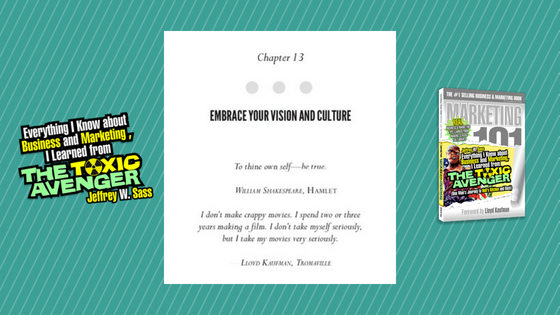Chapter 13: Embrace your Vision and Culture
Greetings from Tromaville! Here is Chapter 13 from my book, Everything I Know about Business and Marketing, I Learned from THE TOXIC AVENGER. In this chapter, I talk about the “c” word – culture, and how Troma taught me what’s really important to pull a team together (hint: it’s not pizza and beer on Fridays). What do you think?
If you haven’t done so already, you can read the Foreword by Troma co-founder, Lloyd Kaufman, and the Introduction to the book as well as Chapter 1, 2, 3, 4, 5 and 6, 7 , 8, 9, 10, 11 and 12. You can also see me read a few chapters live, along with Lloyd and Toxie, at Florida Supercon as well as a few chapters I read on Facebook Live. Stay tuned for additional chapters to be published here. If you like what you read and can’t wait for more, please don’t be shy. You can buy the book now on Amazon (and also please don’t be shy about sharing, and reviewing the book when you do read it.) Both Toxie and I greatly appreciate your support! – Jeff Sass
Chapter 13: Embrace your Vision and Culture
“To thine own self—be true.”
—WILLIAM SHAKESPEARE, HAMLET
“I don’t make crappy movies. I spend two or three years making a film. I don’t take myself seriously, but I take my movies very seriously.”
—LLOYD KAUFMAN, TROMAVILLE
Willie and Lloyd are both sort of saying the same thing here. Know who you are and embrace it. Self-awareness is as important for a company as it is for each of us as an individual. There is so much talk in the business world today about culture. There are countless books, countless consultants, and countless dollars spent on “culture building” within corporations.
Often these efforts miss the core of what culture really is, what culture really means. Contrary to popular belief, culture is not about pizza and beer on Fridays, or unlimited free snacks in the company dining room (though on a film set of any size or budget, heaven help you if you don’t have a functional craft-services department. The fastest way to throw any film production off course is to fail to feed the crew, and feed them well and often). At its core, culture has more to do with your brand than your office decor.
A great company culture enables and encourages employees to embody and reflect the essence of the brand in their ethic, attitude, and execution of their work. It goes deeper than office environment and is more significant than a list of core values on a whiteboard. A great company culture is one where everyone organically lives and breathes the same brand. A great culture is one where all employees understand and appreciate the DNA of the brand. They don’t have to be it, but they have to believe it.
A great company culture is not a cult (though some of the highly publicized “great-culture” enterprises seem to have lost that distinction) because in a cult the disciples are most often following blindly while in a great company culture the employees are following with purpose. A great culture is created by a shared purpose that will move the company forward toward success.
Defining and communicating that purpose is core to a company’s success. On a film set, the purpose is most often very clear. We are making a movie. The roadmap is the script, literally. The strategy is the production schedule. If the director is a good CEO, then everyone on set knows their role and expected contribution toward the execution of the plan and the fulfillment of the purpose.
In business, the purpose and strategy also need to be clearly defined, and as important, the role each employee plays has to be understood by the employee(s) and management. There needs to be a screenplay and a production schedule for your business.
•••
That’s Chapter 13 – Another valuable lesson I learned making Troma movies: Having a clearly defined purpose and strategy is the best way to create a great company culture! Stay tuned for “Chapter 14: “Strategic Partners: Burn Houses, Not Bridges,” which explores some “hot” lessons about business development learned from location scouting for Troma films.
The book in previous posts:
Foreword, by Lloyd Kaufman
Introduction: Lights, Camera, Action!
Chapter 1: Welcome to Tromaville!
Chapter 2: The Troma Building
Chapter 3: Meet the Moguls
Chapter 4: Trailer Trash
Chapters 5 and 6: Working FREE-lance & Becoming a Full-time Tromite
Chapter 7: Branding Begins on the Ground Floor
Chapter 8: The Power of We
Chapter 9: Old Yeller (and Be Your Brand)
Chapter 10: Find Something to Believe In
Chapter 11: Show Up!
Chapter 12: Sink or Swim!




